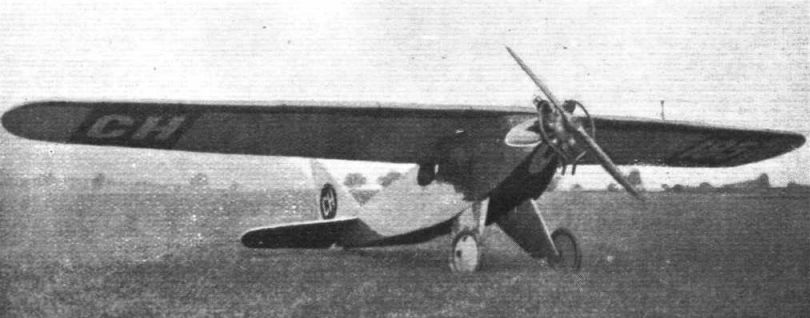
Flight, April 1928
THE "KORSA I"
A Swiss Light 'Plane with 50 H.P. Anzani Engine
SIMPLICITY appears to be the keynote of the little two-seater light 'plane recently produced in Switzerland, and known as the "Korsa I." This machine, designed by the Swiss engineer, Hugo G. Schmid, and built at the Korsa works at Altstetten, Zurich, is a parasol cantilever monoplane, and is characterised mainly by three features: The very narrow base of attachment of wing to fuselage, the trapezoidal cross-section of the latter, and the cantilever undercarriage "legs."
The monoplane wing is of wood construction, with spruce spars and three-ply leading edge, the rest of the wing being fabric covered. The wing is in two halves, designed for easy dismantling, and it will be seen that there are no struts whatever. In view of the fact that the top of the fuselage is only a few inches wide, it would appear that the internal bulkhead of the fuselage would have to be rather substantial so as to take not only torque reaction loads, but also such loads as might be imposed by a fairly violent use of the ailerons during a roll, for instance. Even taxying over rough ground, with first one and then the other wing tip dropping suddenly, some not inconsiderable stresses might be set up, owing partly to the inertia of the wing and partly to the damping action of the air on it.
The fuselage is, as we have already said, of trapezoidal cross section, the sides sloping inward at a fairly pronounced angle from the bottom longerons to the top. Doubtless this arrangement was chosen in order that the view from the "cabin" might be reasonably good. The cabin is entered by a door in the side, and except for the openings in the walls, the occupants are enclosed. Probably the view diagonally forward is not too bad, but it is entirely cut off in an upward direction by the wing. As the machine is intended for touring rather than racing, this fact may not be really of great moment, but we doubt whether the arrangement would find favour in this country. The fuselage is ply-wood covered from the nose to aft of the cabin, the rest being fabric covered.
The 50 h.p. Anzani engine is uncowled and unfaired except for a small aluminium fairing on each side to merge the crank case into the sides of the fuselage. The petrol tank is situated in the wing, gravity feed being employed.
Of unusual design is the undercarriage, which consists of two "trouser legs" entirely independent of each other, and each carrying a wheel on a short stub axle. The two struts are cantilevers, and must be fairly heavy to withstand not only such side loads as may be imposed by landing with a slight drift, but also lateral bending due to the method of mounting the wheels.
The "Korsa I" is certainly of clean design, and in view of its various unusual features we have thought that this brief description might be of interest in showing how a Swiss designer has tackled the problem of a light two-seater.
Following are the main data relating to the "Korsa I" :-
Wing span, 12 m. (39-3 ft.); length overall, 6-8 m. (22-3 ft.); wing area, 17-5 sq. m. (188-5 sq. ft.); weight empty, 300 kg. (660 lb.); useful load and fuel, 260 kg. (572 lb.); gross weight, 560 kg. (1,232 lb.); wing loading, 32 kg. sq. m. (6-54 lb. /sq. ft.); power loading (on 50 b.h.p.), 11-2 kg./h.p. (24-6 lb./h.p.) span2/W 1-25; "wing power," 2-86 hp./sq. m. (0-265 h.p./sq. ft.); maximum speed, 150 km./h. (93 m.p.h.); economical cruising speed, 120 km./h. (74-5 m.p.h.); landing speed, 55 km./h. (34 m.p.h.); climb to 1,000 m. (3,280 ft.) in 4-5 minutes; practical ceiling, 5,400 m. (17,700 ft.). Full-throttle range, 1,000 km. (620 miles); range at cruising speed, 1,200 km. (745 miles). Petrol consumption, 12 litres per 100 km. (23-5 miles per gallon).
Everling Quantities
High-speed figure = 22
Distance figure = 6-3
Altitude figure = 8 - 8
All three figures are high and point to an efficient design, provided the performances claimed are actually attained.
- Flight, April 1928
THE "KORSA I"
Фотографии
-
Flight 1928-04 / Flight
Регистрационный номер: CH-185 [3] A SWISS LIGHT 'PLANE: Three-quarter front view of the "Korsa I" monoplane, which is fitted with a 60 h.p. Anzani engine.
-
Flight 1928-04 / Flight
Регистрационный номер: CH-185 [3] A SWISS LIGHT 'PLANE: Side view of the "Korsa I" monoplane, which is of the totally enclosed cabin type.
-
Flight 1930-05 / Flight
Регистрационный номер: CH-185 [3] WE show in the accompanying illustrations two views of a new Swiss light 'plane, the "Korsa T2," constructed by Hugo G. Schmid at the Korsa works at Altstetten, Zurich. The forerunner of this neat little 'bus, "Korsa 1" (which was described in FLIGHT for April 5, 1928) was destroyed on its first flight, so a model was made and tested in the Mind tunnel at Goettingen. The tests were so promising that "Korsa T2" was built, and Mr. Schmid has already flown it for more than 50 hours with excellent results.
- Фотографии


